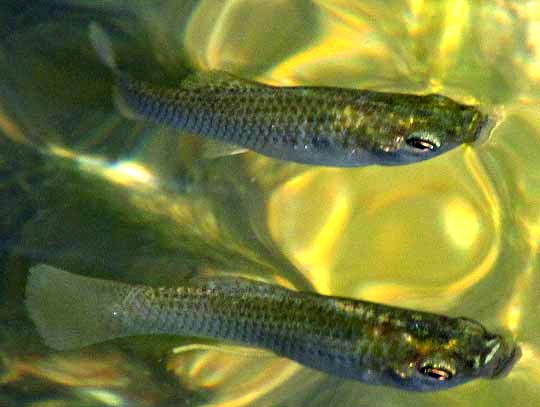Excerpts from Jim Conrad's
Naturalist Newsletter
from the June 14, 2015 Newsletter issued from Río Lagartos, on the Yucatan Peninsula's northern coast (~N21.60°, ~W88.16°), Yucatán state, MÉXICO
SHORTFIN MOLLIES
I've mentioned that sometimes masses of minnow-sized, grayish-brown fish appear at the water's surface in pools, such as where the estuary's brackish water flows back and forth beneath culverts in the levee south of town separating the estuary and the mangroves. We've seen that these schools are mostly Yucatan Gambusias with a few Yucatan Mollies. Also are part of the mix are the ones shown below:

These look a good bit like Yucatan Gambusias, which you can compare at www.backyardnature.net/mexnat/gambusia.htm.
But notice that this one'smouth is narrower, more "puckery," and that each of its scales is two-toned, highlighting each scale.
*UPDATE: First I thought this was a Rainwater Killifish, Lucania parva. However, in 2024 which many more Internet resources are available, when I upload this image to iNaturalst, user "jkmaxfield" recognizes that we have a member of the genus POECILIA. When I look into Poecilia, there's the Shortfin Molly, POECILIA MEXICANA, looking just like our image. I'll fill this page under that name, so others can find it, though it's clear that there's much is yet to be understood about the species in this genus.
Shortfin Mollies live in fresh and brackish water, They seem to be native to Mexico and Guatemala, but have been recorded in many other places as invasives, including in the US and other tropical countries.